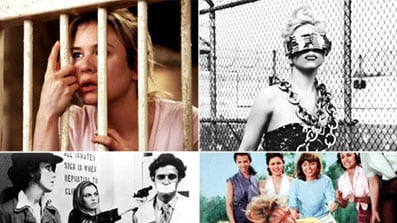Since its debut last week, Lady Gaga's "lezploitation" music video " Telephone" has been the talk of the Internet, racking up 15 million hits on YouTube alone. The nine-minute medley of sex and violence, mad fashion and Beyoncé is a homage to one of the most venerable subsets of trash cinema—the women in prison movie.
Click the Image Below to View Our Gallery of Women in Prison

After a century of hair-pulling catfights and gratuitous shower scenes, "chicks between sticks" have gotten plenty of geeky pop culture due, but this is the genre's first taste of global viral acclaim.
The women-in-prison genus has been in steady use since the 1920s, and its rules and clichés are among the most strictly observed of exploitation fare. "Telephone" is no exception, and reverently starts with a New Fish (Lady Gaga) arriving at a jail to Run the Gauntlet of Leering Inmates before being Sexually Assaulted by pair of strapping Lesbian Guards.
Sadly, the video epic doesn't have time to include other staples of the category, such as the Sadistic Warden; the Queen Bee; the Inmate on the Edge, usually carrying a pet mouse; the Wise Old Lifer, who generally works in the library; and the aforementioned Shower Scene. This last one is a glaring omission, rather like reviving Oklahoma! without "The Surrey With the Fringe on Top."
Click the Image to Watch the Lady Gaga/ Beyoncé Video for "Telephone"
But "Telephone"—directed by Jonas Åkerlund—makes up for these omissions with a vicious catfight, a mass murder, and a deadpan Beyoncé doing a Kill Bill homage as the "butch top" in this criminal partnership. "You've been a very bad girl," she tells her wayward lover. "A very, very, bad, bad, girl, Gaga."
Obviously, "ass under glass" movies, as they are sometimes called, are pure fantasy, but the best examples throb with a heartfelt primitivism that gives them an enduring charm. "I took it seriously," said Pam Grier, who starred in four women-in-prison movies in 1970s, including Black Mama, White Mama, and The Big Doll's House. "Even though I was doing what was considered a B-movie," she told AV Club in 2003, "I thought it was Gone With the Wind. I thought it would win an Oscar."
The forbidden appeal of the genre can be summed up in the tagline from Forced Females, one of many '50s pulp paperbacks about female life behind bars: "They were treated like animals and made to love it!"
Exploitation films get their adrenalizing effect by yoking together fear and desire, but it is the second part of that sentence that separates female prison movies from male ones.
In men-in-prison films, the jail is a dehumanizing machine that grinds down the inmates until they escape or die trying. No hero is in danger of getting a taste for institutional brutality because, like actual prison, it's just ghastly.
In the female prison movie, by contrast, jail is a secretly awesome place where inmates actually blossom by unleashing their bestial passions. Uncontainable passion is not just a major preoccupation of the archetype, it's the bedrock.
The genre's two high points were the early 1950s and early 1970s, and it is no coincidence these golden eras followed periods of major feminine empowerment. World War II put women into the workplace—and the male subconscious coped by unleashing a string of femme fatales and bad girl exploitation movies.
The era of bra-burning feminism in the 1970s was even more fruitful, leading to exploitation classics like Chain Gang Women, Caged Heat ,and The Big Bird Cage ("Women so hot with desire they melt the chains that enslave them!"). Ilsa, She Wolf of the SS remains the most notorious. Made in 1974, and filmed on the set of Hogan's Heroes, this came with the ineffable tagline: "My name is Ilsa. I turned my lovers into lampshades!"
The past three decades have seen women-in-prison films decline into direct-to-video self-parody and worse, mainstream dullness (anyone care to revisit Brokedown Palace?). But Lady Gaga's pop impresario genius has been to take this most transparently base and male-centric of exploitation fare and use it for her own ends. Thanks to her dense, witty cut-and-paste exploration into fame and female sexuality, she has done something unprecedented for fans of the women-in-prison genre: She's restored its taboo and made it intellectually respectable at the same time.
Sean Macaulay was the L.A. movie critic for The London Times from 1999 to 2007. He has also written for Punch, British GQ, and The Mail on Sunday. He was most recently creative consultant on the award-winning documentary Anvil! The Story of Anvil.






